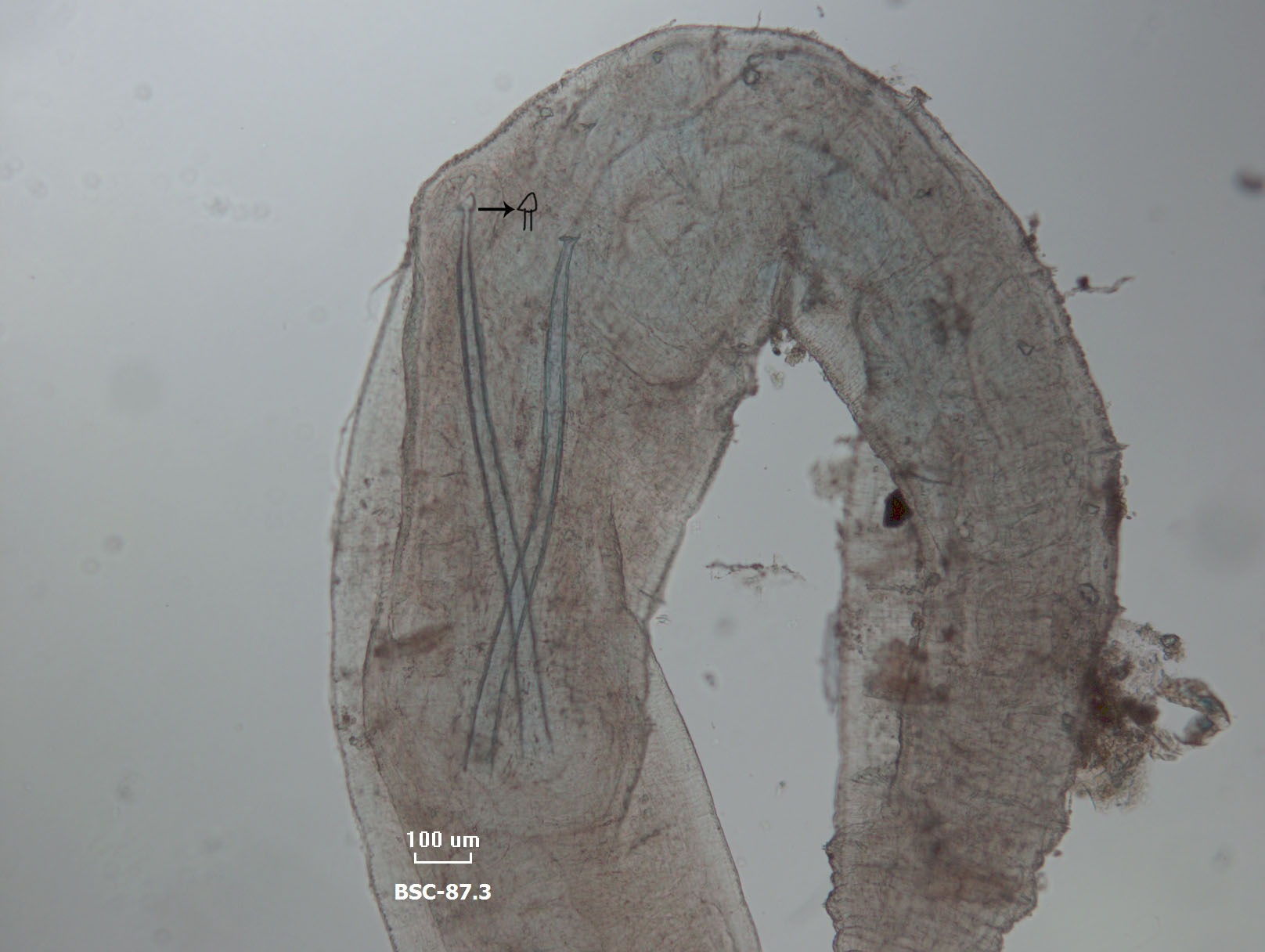
Limnodrilus claparedeianus Ratzel, 1868 is a freshwater oligochaete worm that is common in the Great Lakes. It is a tubificid worm with bifid dorsal and ventral chaetae beginning in II and long cuticular penis sheaths in XI when mature. The anterior bundles have 4–9 chaetae, with fewer in posterior bundles. It is common for Limnodrilus spp. to have variation in the chaetae, but the upper teeth of L. claparedeianus are usually longer and range from thinner to just about as thick as the lower. The penis sheaths are 800–1100 μm long, sometimes up to 1300 μm, and may be sigmoid. The head plate is set at a slight angle to the shaft and is symmetrically triangular. There is some variation in the head, and sometimes a worm bearing thick walls but a triangular head without a digitate lower lobe is viewed as either a variant form of L. cervix or a cross between L. cervix and L. claparedeianus. There are also variants in more enriched sites with thinner walls that may belong to L. claparedeianus or the hybrid. There is evidence that L. cervix/claparedeianus is genetically distinct enough from L. claparedeianus to be its own species (Liu et al. 2017).
L. claparedeianus is mainly identified by long penis sheaths, without which it will just appear as an immature tubificid worm without hairs. The penis sheaths are around 1000 μm long with single-layered, thin walls, and a small, triangular head plate. The chaetae are all bifid with the upper tooth a little longer and thinner than or as thick as the lower, and no hair chaetae.
L. claparedeianus can be found in soft substrates, most abundantly in sites with organic enrichment, but also in clean water environments. It is not usually found in highly polluted or degraded habitats unless it is the variant or hybrid, L. cervix/claparedeianus.
Lakes Erie, Huron, Michigan, and Ontario.
Without the presence of reproductive features, many tubificid worm species can only be identified as “immature tubificid with or without hair.” The length of the penis sheaths separates L. claparedeianus from most of the other Limnodrilus species, but it still could be confused with L. cervix, L. cervix/claparedeianus hybrid, and L. maumeensis. L. claparedeianus may have penis sheaths as long as or longer than L. cervix, but the head of L. claparedeianus is usually a small, symmetrical triangle at a slight angle to the shaft, with no digitate lower lobe, and the shaft is thin with only one layer. There are some specimens that appear to be a cross between L. cervix and L. claparedeianus, often denoted as L. cervix/claparedeianus. These specimens share features of both species, with a smaller, triangular head plate and thickened walls, or a larger head with a lower digitate lobe and thinner, almost one-layered walls. L. claparedeianus is also similar to L. maumeensis because they both have one layered walls and are generally the same size, but in L. maumeensis the walls of the shaft are much thicker and one side may be thicker than the other because there is often a curve, slight or pronounced, in the shaft near the head plate. L. maumeensis has a wide, triangular head with a curved upper tip, whereas L. claparedeianus has a smaller triangular head plate that does not have a curved tip. Finally, there is a chance that the penis sheaths may be shorter than 1000 μm so it could be confused with L. hoffmeisteri. In that case, the shape of the head plate is the most important. L. hoffmeisteri has many different head plate shapes, but the closest might appear triangular but be composed of an overhanging hood and a broad lower lip. L. claparedeianus will be a flat triangle with no overhanging hood.
Another species with long penis sheaths and bifid chaetae is Varichaetadrilus angustipenis. The length is not noted in the keys, but it has long penis sheaths with small head plates usually perpendicular to the shaft, with the basal portion conical instead of cylindrical and sometimes crumpled. The other identifying factor is having chaetae in II with the upper tooth distinctly shorter and thinner than the lower. L. claparedeianus has a cylindrical shaft with a small, triangular head, but all of the bifid chaetae usually have the upper tooth a little longer and thinner than or as thick as the lower, not distinctly shorter.
L. claparedeianus is a relatively large freshwater oligochaete.
Yes, this species does have a barcode reference from the Great Lakes.
 This work is licensed by Susan Daniel under a Creative Commons Attribution-NonCommercial 2.0 Generic License.
This work is licensed by Susan Daniel under a Creative Commons Attribution-NonCommercial 2.0 Generic License.

Figure 1. The penis sheaths of L. claparedeianus are very long and thin, with a small triangular head.
Liu, Y., S.V. Fend, S. Martinsson, and C. Erséus. 2017. “Extensive cryptic diversity in the cosmopolitan sludge worm Limnodrilus hoffmeisteri (Clitellata, Naididae).” Organisms, Diversity, & Evolution 17:477–495.
Kathman, R.D., and R.O. Brinkhurst. 1998. Guide to Freshwater Oligochaetes of North America. pp. 160–161, 134, 154–162, 172–173.
Stimpson, K.S., D.J. Klemm, and J.K. Hiltunen. 1982. A Guide to the Freshwater Tubificidae (Annelida: Clitellata: Oligochaeta) of North America. pp. 36–39, 46.
Some content on this page is saved in PDF format. To view these files, download Adobe Acrobat Reader free. If you are having trouble reading a document, request an accessible copy of the PDF or Word Document.
